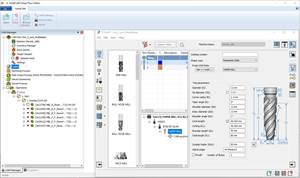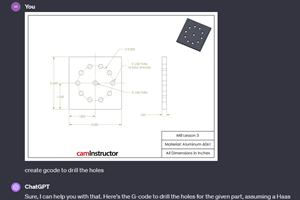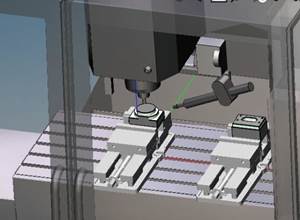Software Switch Leads To Improved Surface Finishes
MSI Products, a division of Dixie Iron Works (Alice, Texas) faces the challenge of building products with complex geometries for the oil- and gas-producing industries in relatively low volumes. The company struggled with programming software that was not able to import the complex assembly models needed to define its products or fully support the functionality of its CNC machine tools. This meant programmers had to define machine movements with lines of G code.
Share





MSI Products, a division of Dixie Iron Works (Alice, Texas) faces the challenge of building products with complex geometries for the oil- and gas-producing industries in relatively low volumes. The company struggled with programming software that was not able to import the complex assembly models needed to define its products or fully support the functionality of its CNC machine tools. This meant programmers had to define machine movements with lines of G code.
However, transitioning to a different CAM package enabled MSI not only to import complicated assembly models, but also to automate programming so that programming time for the fluid end of an oil field pump went from 25 hours to 8 hours.
High-pressure plug valves, fittings, chokes, manifolds and service pumps for the oil and gas industry are MSI Products’ specialty. The company’s TI-600 “well service pump” is a 600-hp, triplex pump with a 16-position gear box for left- and right-hand configurations. The pump also has two fluid end options for either high-pressure or high-volume service; a power frame designed for added strength and longevity; a plunger greasing system that can be installed and shipped with the pump; and a phosphate coating on all internal and external components for corrosion protection.
The fluid end of the TI-600 is a programming challenge because of its geometric complexity. It has a large number of different diameter bores and radii, as well as grooves stacked on top of one another. Built of 4330 modified steel, the part requires machining on all six sides. The company says it continually reprograms this part to provide custom designs for customer-specific applications. The software used in the past established the basic geometry and generated about 70 percent of the code during post-processing. About 30 percent of the program, including cut statements, had to be written one line at a time. In addition to requiring the expertise of a skilled programmer, this method entailed lengthy programming times. Debugging on the machine tool was also time-intensive because one incorrect character could cause the program to fail to run properly.
Because of these kinks in the programming process, MSI switched to software capable of automating many of the tasks involved in creating a CNC program. The program accepts geometry created by CAD software to enable programmers to easily assign machining operations to features. However, the company’s programmers also discovered shortcomings in the software.
Components with complex geometries, particularly those defined as assembly models, would either fail to import or would be imported with major errors. This meant that programmers had to spend a considerable amount of time trying to recreate the geometry in an environment lacking in many of the tools provided by CAD. Another problem was that the CAM software did not support many of the features found on the company’s newer machines, such as milling spindles and subspindles on lathes. In the end, MSI was forced to return to using its older software because of time constraints.
After using this program briefly, the company resumed its search for new software after viewing demonstrations of various CAM software packages. MSI says it found that all but one lacked something crucial. For example, one package was unable to import the company’s larger assembly models.
“We often need to import assembly models because that’s how we define weldments,” says Marc Pollok, process improvement manager at MSI Products. “On the other hand, Esprit by DP Technology (Camarillo, California) provided all of the capabilities necessary for our applications. It can import our most complicated models without errors and provides specific features to address many of our toughest challenges, such as driving subspindles on our lathes.”
The fluid end of the TI-600 was one of the first parts that MSI used to test the performance of the new software. The company had recently obtained a special boring tool from Forth Tool & Valve Ltd. that changes diameter in response to spindle motion. In turn, the spindle can be controlled through the CNC program. The boring tool can potentially reduce the time spent machining components like the fluid end, in which various different bores need to be machined. The tool accomplishes this by providing a milling machine with what MSI refers to as “lathe-like control” over the cutting tool.
“This tool works the same way as a cutting tool in a lathe except that in this case, the tool is rotating rather than the workpiece,” explains Terry Evans, process improvement specialist at MSI.
As a first step, Mr. Evans and Damian Ybarra, who is also a process improvement specialist at the company, imported the geometry of the fluid end into Esprit from the native SolidWorks file. The geometry arrived with all surfaces intact. According to the company, this made programming the machining of 3D contours as easy as programming flat surfaces with the old software. One section of the geometry had to be programmed as one would a program a lathe, while the rest was programmed like a machining center. The programmers divided the geometry into two sections that could be addressed separately.
For each section, the programmers used the software’s feature recognition capabilities to divide the surface into sections that could be assigned to cutting tools. Previously, the company had used the knowledge-based machining features of Esprit to create operations that match cutting tools and machining parameters to the features and materials frequently produced by the firm.
“Once we establish what works for a particular feature and material, we save the cutting tools and the process for future use,” says Mr. Ybarra. “That way, when we are programming a new part, we can open up a library and drag these operations onto features.”
Mr. Ybarra points out that the company can use this feature with the 1502 threaded ACME connections that are used in various products.
After attaching operations to all of the features, the next step is simulating the machining sequence to ensure that the part adheres to the desired specifications. In addition to verifying the accuracy and the surface finish of each part, simulation provides a platform for users to search for ways to enhance productivity.
After the programmer has validated the program on the computer, he or she invokes the postprocessor to generate the G code specific to the machine tool on which the part will be run. The software also includes a post-processor generator to modify existing posts or originate posts from scratch.
“By implementing Esprit, we have drastically reduced our programming and have improved productivity,” Mr. Pollok concludes. “It took about 25 hours to program the fluid end of the TI-600 and similar parts when we wrote G codes with our previous system. After the switch, we were able to initially reduce this to about 20 hours.”
However, Mr. Pollock adds that through the system’s import capabilities, knowledge-based machining features and postprocessors, MSI has further reduced programming time on this part to 8 hours. The company has realized reductions of a similar magnitude in
all of its complex programming jobs. Simple programming tasks have also been improved, although not by such a significant amount.
Related Content
Building A Powerful Bridge from the CAM Programmer to the Shop Floor Operator
SolidCAM for Operators provides a powerful bridge from CAM programming to the shop floor to best streamline the machine shop process with its CAM part simulation. It provides a clear picture to the operator for setup and prove-out, enables minor G-Code changes and avoids crashes, broken tools and scrapped parts.
Read MoreCan ChatGPT Create Usable G-Code Programs?
Since its debut in late 2022, ChatGPT has been used in many situations, from writing stories to writing code, including G-code. But is it useful to shops? We asked a CAM expert for his thoughts.
Read MoreTTI Brings Specialty Gear Production In-House with Multiaxis Machining
By investing in a 3+2-axis machine and utilizing simulation software for diagnostic checks, Techtronic Industries turned a four- to ten-week lead time into a one- to two-week lead time.
Read MoreHow Integrated CAD/CAM Transforms Inventions Into Products
The close connection between CAD and CAM is what links creative ideas to practical production for this unique custom manufacturer.
Read MoreRead Next
AMRs Are Moving Into Manufacturing: 4 Considerations for Implementation
AMRs can provide a flexible, easy-to-use automation platform so long as manufacturers choose a suitable task and prepare their facilities.
Read MoreLast Chance! 2025 Top Shops Benchmarking Survey Still Open Through April 30
Don’t miss out! 91 ”∆µÕ¯’挀's Top Shops Benchmarking Survey is still open — but not for long. This is your last chance to a receive free, customized benchmarking report that includes actionable feedback across several shopfloor and business metrics.
Read MoreMachine Shop MBA
Making Chips and 91 ”∆µÕ¯’挀 are teaming up for a new podcast series called Machine Shop MBA—designed to help manufacturers measure their success against the industry’s best. Through the lens of the Top Shops benchmarking program, the series explores the KPIs that set high-performing shops apart, from machine utilization and first-pass yield to employee engagement and revenue per employee.
Read More






















